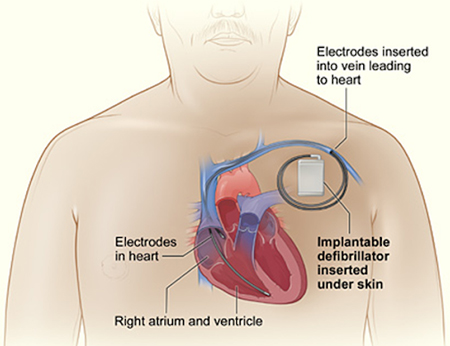AICD

AICD stands for Automatic Implantable Cardioverter Defibrill-ator. It is a tiny electronic device which helps to monitor as well as regulate the heartbeats of a person suffering from arrhythmia, a condition marked by an abnormality in the heart rhythm. The heart of a person suffering from arrhythmia either beats too fast (Tachycardia), too slow (Bradycardia) or irregularly (Atrial Fibrillation). The device is programmed to speed up or slow down your heart rates in order to maintain a normal pace. In case the arrhythmia causes your heartbeat to stop, the device generates a shock which can help it to beat normally once again.
Although the device is quite small it can collect and store the information related to your heart’s electrical activity which can be easily accessed by the doctor. The device is surgically implanted inside the chest cavity, close to the heart. An AICD usually has two components – electrodes and generator. The former refers to a set of thin flexible wires that sense and monitor the electrical activity whereas the latter is the source of power and stores information.
Indications of AICD
AICD may be recommended for any of the following reasons:
- A previous episode of Ventricular Tachycardia (VT) or Ventricular Fibrillation (V-fib)
- A history of cardiac arrest or abnormal heart rhythm that has led to unconsciousness
- Persistent tachycardia that is posing a serious threat to the patient’s life
- Tachycardia that cannot be cured surgically or by using medication.
If you can relate with any of the above-mentioned problems, your doctor will recommend an Electrophysiological study (EP study) to figure out whether you are eligible for the procedure. EP study helps to evaluate the heart’s electrical system using fluoroscopy.
Implantation
AICD can be implanted very easily, without the need of any major surgery. The whole procedure is performed under the influence of local or general anaesthesia. The patient’s arms are strapped to prevent any movement. This is followed by making a small incision on the patient’s chest, just below the collarbone. A wire is introduced via a vein into your heart. In some cases, more than one wire may also be used. A small pocket is created in the chest for the placement of the AICD. Once the device is in the right position, the wires are connected and the device is tested. The device is tested again on the next day using a programmer. This procedure is medically termed as"non-invasive programmed stimulation" or "pre-discharge testing".
Recovery
The recovery period is very short and takes around 3 to 4 days, after which the patient can return back to his normal lifestyle. However, healthy lifestyle modification and regular medication are a must. Patients are usually recommended to avoid sudden jerks to the left shoulder for a week or two, in order to prevent the displacement of the leads. Here are few more precautions that should be followed religiously:
Short-term precautions
- Avoid lifting heavy objects
- Refrain from indulging in rigorous activities
- Avoid vigorous above-the-shoulder activities
Long-term precautions
- While talking on cell phones, it is important to maintain a distance of at least 6 inches from the screen.
- AICD can set off security alarms at airports and malls. The magnets present in metal detectors, too, can interfere with the normal working of the device.
- Inform your doctors about the device before undergoing any treatment or diagnostic procedure.
- Maintain a distance of at least 2 feet from high voltage electrical devices like transformers, welding machines etc.
- Avoid using headphones as these contain magnetic substances that can interrupt the normal functioning of the AICD device.
Working
When the wires detect a rapid heartbeat, they transmit signals to AICD, which in turn generates electronic pulses to regulate the heartbeat. Usually, a single shock suffices, however, in some cases, two or more shocks may be experienced within a period of 24 hours. Patients experiencing 3 or more shocks are said to be having an electrical or arrhythmia storm. In such cases, it is important to seek immediate medical help. An AICD can be programmed to suit your specific needs.
- Low energy pacing- When AICD tends to the mild disruptions in your heartbeat, you may either feel nothing or a slight fluttering which is painless.
- Higher energy shock- In the case of severe arrhythmia, AICD generates high impact shock which is slightly painful and feels like a sudden blow to the heart.
What happens after the batteries wear out?
AICD generator derives its power from batteries and these can get exhausted over time. How long a generator lasts depends upon two factors:
- The settings that have been programmed into the system
- The amount of therapy that the patient needs
When the batteries are exhausted, the doctors open the AICD pocket and replace the old generator with a new one. The doctors also check the leads to make sure that they are still in a proper working condition. The steps that follow are the same as in case of the prior surgery.


